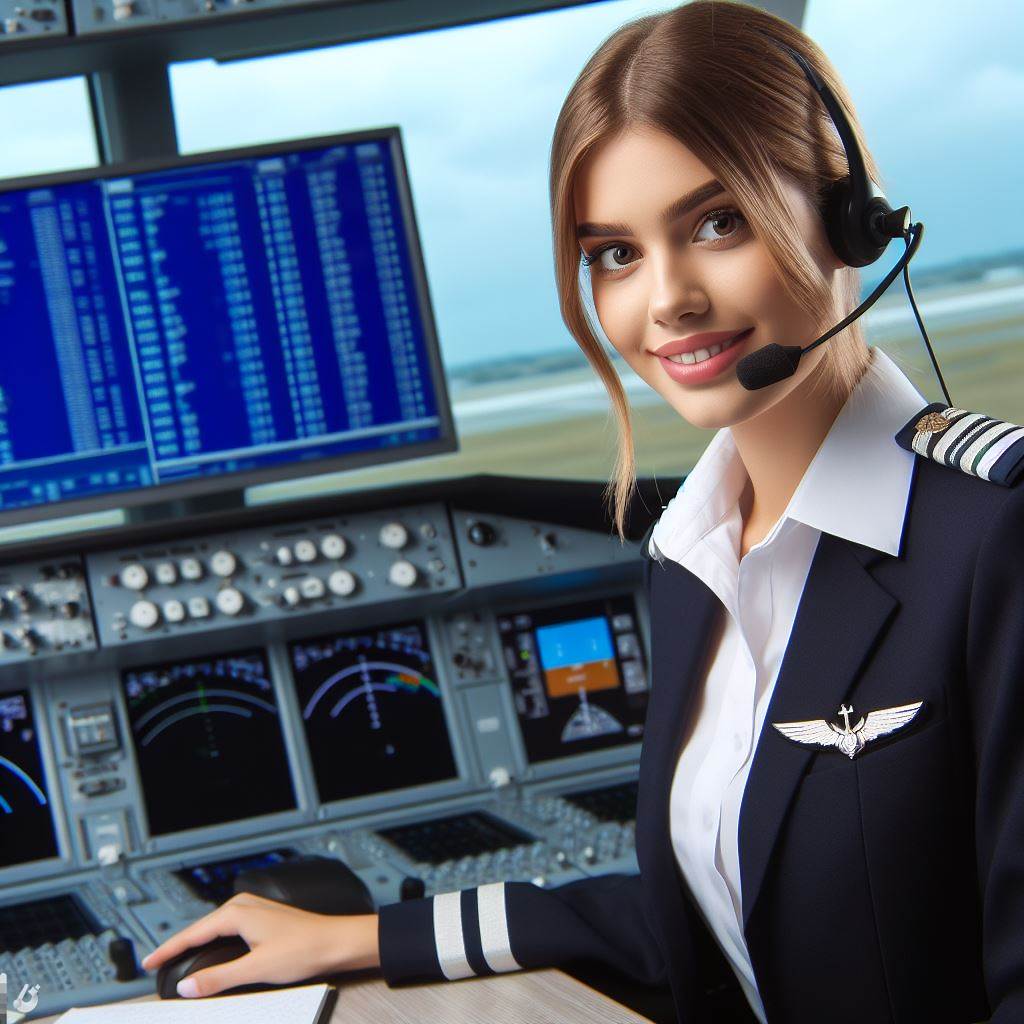Introduction
A. Definition and Role of ATC in UK Airspace
Air Traffic Control (ATC) in the UK is the vigilant oversight of aircraft movements, ensuring safe navigation.
B. Importance of ATC in Ensuring Safe and Efficient Air Travel
- Safety Assurance: ATC prevents collisions, managing airspace congestion for secure flights.
- Efficiency Enhancement: ATC streamlines air traffic, reducing delays and optimizing routes for quicker journeys.
- Emergency Response: Swift ATC coordination aids in responding to emergencies, ensuring a rapid, controlled resolution.
- Communication Hub: ATC serves as a communication hub, facilitating effective pilot-ground and pilot-pilot interactions.
- Weather Management: Monitoring weather conditions, ATC guides planes to avoid turbulence, ensuring passenger comfort and safety.
This blog section unravels the complexities of ATC in the UK, spotlighting its pivotal role in safe, efficient, and organized airspace navigation.
Overview of UK Airspace
A. Classification and division of UK airspace
- UK airspace is divided into controlled and uncontrolled airspace.
- Controlled airspace is further divided into Class A, B, C, D, and E airspace.
- Class A airspace is used for high-altitude air traffic and is fully controlled by air traffic control (ATC).
- Class B airspace is used for major airports and is also fully controlled by ATC.
- Class C airspace is used for smaller airports with lower traffic volume and has some control from ATC.
- Class D airspace is used for smaller airfields and has less control from ATC.
- Class E airspace is used for specific purposes, such as military operations or glider activities.
B. Air traffic flow and busiest airports in the country
- The United Kingdom has some of the busiest airspace in the world.
- London Heathrow Airport is the busiest airport in the UK and one of the busiest in the world.
- It handles a large number of international flights and is a major hub for connecting flights.
- Other major airports in the UK include London Gatwick, Manchester, Birmingham, and Edinburgh.
- These airports handle a significant amount of domestic and international air traffic.
- The air traffic flow in the UK is managed by the National Air Traffic Service (NATS).
- NATS operates control centers and radar installations to monitor and direct air traffic.
In fact, UK airspace is classified and divided into controlled and uncontrolled airspace, with different classes of controlled airspace depending on the level of control from ATC.
The busiest airports in the country, such as London Heathrow, London Gatwick, Manchester, Birmingham, and Edinburgh, handle a large volume of domestic and international air traffic.
The National Air Traffic Service (NATS) is responsible for managing the air traffic flow through control centers and radar installations.
Navigating UK airspace poses challenges for air traffic controllers due to the high volume of traffic and the need to ensure safety and efficiency in the skies.
Read: How UK ATCs Handle Extreme Weather Scenarios
Challenges Faced by ATC in UK Airspace
Air Traffic Control (ATC) in the United Kingdom (UK) faces numerous challenges when it comes to navigating the country’s airspace.
These challenges have a significant impact on the efficiency and safety of air travel.
A. Volume of air traffic
The volume of air traffic in UK airspace has increased significantly over the years.
This increase can be attributed to various factors, including the growth of the aviation industry and the rise in demand for air travel.
As the number of flights continues to rise, ATC must find ways to manage the increased workload efficiently.
Another challenge faced by ATC is managing peak travel seasons and special events.
During these periods, such as holidays or major sporting events, there is a surge in air traffic.
ATC must ensure that all flights are managed effectively, minimizing congestion and delays.
Personalized UK Career Consulting
Receive tailored career guidance designed just for you. Get actionable steps and expert support to boost your career in 1-3 days. Take control of your career now.
Get StartedB. Weather conditions
Weather conditions have a significant impact on air traffic in the UK.
Fog, snow, and strong winds can disrupt operations and pose challenges for ATC.
Reduced visibility due to fog or heavy snow can result in delays and diversions.
Strong winds can make it difficult for aircraft to maintain their intended flight paths.
ATC must closely monitor weather conditions and make necessary adjustments to ensure the safety of flights.
Additionally, the UK experiences unpredictable weather patterns, which further complicate ATC operations.
Sudden changes in weather can require rerouting or altering flight plans, causing disruptions in the flow of air traffic.
ATC must constantly adapt their strategies to account for these unpredictable weather patterns.
C. Complex airspace structure
The airspace structure in the UK is complex, presenting challenges for ATC.
It comprises both controlled and uncontrolled airspace, each with its own set of regulations and requirements.
Navigating through this intricate airspace structure requires ATC to have a thorough understanding of the rules and procedures.
Furthermore, as the UK shares borders with neighboring countries, ATC must coordinate with their ATC systems.
This coordination ensures seamless operations and the safe passage of flights across borders.
Collaborating with neighboring countries’ ATC systems requires effective communication and adherence to international aviation standards.
Your Dream Job Starts with a Perfect CV
Get a tailored CV and cover letter that captures your unique strengths and stands out in your industry. Let us help you make an unforgettable first impression.
Get StartedIn essence, ATC in the UK faces several challenges in navigating the country’s airspace.
The volume of air traffic, weather conditions, and complex airspace structure all contribute to the complexity of the task.
However, through effective management, coordination, and adaptation, ATC strives to ensure the smooth and safe operation of air travel in the UK.
Read: UK ATC: Essential Skills for Success

Technology and Solutions
In the dynamic realm of UK airspace, addressing ATC challenges requires a multifaceted approach.
This section delves into technological advancements and innovative solutions pivotal for navigating the complexities of the sky.
A. Radar and Surveillance Systems
- Radar, a pivotal tool, monitors and tracks aircraft, ensuring airspace safety and efficient traffic management.
- Advanced surveillance technologies seamlessly integrate, enhancing airspace awareness and control capabilities.
Radar stands as a linchpin in airspace management. Its role extends beyond tracking; it’s the vigilant eye ensuring the safety of every aircraft traversing the skies.
The integration of advanced surveillance technologies complements radar, elevating the precision and responsiveness of airspace monitoring.
These technologies, from ADS-B to multilateration systems, contribute to a comprehensive airspace surveillance network.
B. Communication Systems
- Clear, efficient communication between ATC and pilots is paramount for safe and streamlined airspace operations.
- Implementation of cutting-edge communication technologies fosters real-time information exchange, minimizing potential risks.
Efficient communication is the lifeblood of air traffic control. The importance of clear and real-time exchanges between ATC and pilots cannot be overstated.
Advanced communication technologies, including data link communications and voice over internet protocol (VoIP), are instrumental in reducing misunderstandings and enhancing situational awareness.
C. Collaborative Decision-Making
- Optimal flight operations result from cooperative efforts among ATC, airlines, and airports in collaborative decision-making.
- Utilizing data and software tools empowers stakeholders to make informed decisions, improving overall airspace efficiency.
Collaboration is key in optimizing flight operations. Airlines, airports, and ATC must work in tandem, sharing data and insights.
Collaborative decision-making, facilitated by advanced software tools, enables stakeholders to make swift, well-informed choices.
This synergy minimizes delays, reduces environmental impact, and enhances the overall efficiency of the airspace system.
Optimize Your LinkedIn for Success
Boost your LinkedIn profile with a professional bio, keyword-rich headline, and strategic recommendations that attract recruiters. Stand out from the crowd and get noticed.
Optimize NowTo summarize, the intersection of radar advancements, communication innovations, and collaborative decision-making forms the bedrock of a safer and more efficient UK airspace.
Embracing these technologies ensures that the skies remain a testament to human ingenuity and cooperation.
Read: UK Logistics: Skills for Success in Coordination
Learn More: UK Truckers’ Guide to Efficient Routing
Safety Measures and Regulations
Air Traffic Control (ATC) is a critical component of the aviation industry, responsible for guiding aircraft through UK airspace.
To ensure utmost safety, several measures and regulations are put in place.
A. Training and qualifications for ATC personnel
Specific educational qualifications and specialized training programs are requirements for ATC personnel.
These measures aim to equip them with the necessary skills and knowledge to perform their duties effectively.
1. Educational requirements and specialized training programs
ATC personnel must meet certain educational criteria, which generally include a degree in air traffic management or a related field.
In addition to formal education, they also undergo rigorous training programs that focus on various aspects of air traffic control operations.
2. Certification and licensing processes
To ensure that ATC personnel are competent and qualified, they must obtain the necessary certifications and licenses.
These processes involve assessments, examinations, and practical evaluations to assess their aptitude and proficiency in handling various ATC responsibilities.
B. Compliance with international aviation standards
Maintaining compliance with international aviation standards is crucial for the safe operation of UK airspace.
This involves adherence to various regulations and guidelines set by global aviation authorities.
1. Role of regulatory bodies like the Civil Aviation Authority (CAA)
The Civil Aviation Authority (CAA) is the regulatory body responsible for overseeing aviation safety in the UK.
They establish and enforce regulations that govern air traffic control operations, ensuring compliance with international standards.
2. Adherence to procedures and protocols for safe air travel
Specific procedures and protocols, designed for safe air travel, train ATC personnel to follow them diligently.
These protocols include maintaining a safe distance between aircraft, accurate communication with pilots, and managing air traffic flow efficiently.
By adhering to these protocols, potential risks and incidents can be minimized.
In general, safety measures and regulations play a vital role in navigating UK airspace.
The training and qualifications of ATC personnel, along with compliance with international aviation standards, contribute to the overall safety of air travel.
The aviation industry aims to ensure a secure airspace by rigorously training ATC personnel, enforcing stringent requirements, and following protocols.
Read: A Day in the Life of a UK Logistic Coordinator
Conclusion
A. Challenges Faced by ATC in UK Airspace
Navigating UK airspace poses unique challenges for Air Traffic Controllers (ATCs): dense air traffic, adverse weather conditions, and evolving regulations.
B. Importance of Technology, Collaboration, and Regulations
- Technology: Advanced radar systems and AI enhance ATC’s ability to manage complex air traffic scenarios.
- Collaboration: Effective communication among ATCs, pilots, and aviation authorities is vital for seamless operations.
- Regulations: Stringent rules ensure safety and order, guiding aircraft movements and preventing potential conflicts.
C. Appreciation for the Crucial Role of ATC
In the end, ATCs are the unsung heroes of aviation, ensuring safe and efficient air travel.
Their vigilance and expertise, coupled with cutting-edge technology and collaboration, navigate the challenges of UK airspace.
Let’s appreciate these professionals for their unwavering commitment to the skies, fostering an environment where millions soar safely.
[E-Book for Sale]
500 Cutting-Edge Tech Startup Ideas for 2024 & 2025: Innovate, Create, Dominate
$19.99 • 500 Tech Startup Ideas • 62 pages
You will get inspired with 500 innovative tech startup ideas for 2024 and 2025, complete with concise descriptions to help you kickstart your entrepreneurial journey in AI, Blockchain, IoT, Fintech, and AR/VR.




